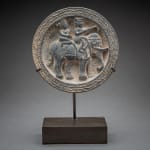Schist Cosmetic Dish Depicting a Royal Procession, 100 BCE - 300 CE
Schist
1.9 x 13.2 cm
3/4 x 5 1/4 in
3/4 x 5 1/4 in
SF.072
A schist cosmetic dish crafted between 100BCE and 300CE, depicting an elephant carrying two passengers. The primary passenger carries fruit above the elephant's head, perhaps as an enticement for the...
A schist cosmetic dish crafted between 100BCE and 300CE, depicting an elephant carrying two passengers. The primary passenger carries fruit above the elephant's head, perhaps as an enticement for the animal. This dish testifies to the skills possessed by the ancient Gandharan craftsmen which produced it. We see a multitude of finely carved intricacy across all areas of the dish, from the patterning around the rim, to the detailing of the central motif with two figures riding an elephant.. The dish is in excellent condition and would make a wonderful addition to any collection. Behrendt (The Art of Gandhara in the Metropolitan Museum of Art) identifies the theme of a similar artefact as a royal procession, noting that elephants commonly feature in early Indian depictions of such occasions. Furthermore, she proposes that the scene might commemorate a coronation.
Situated on the border between what is now Pakistan and Afghanistan, the kingdom of Gandhara contained several notable cities that flourished between the 6th century B.C. and the 11th century A.D. It saw enormous changes with the ebb and flow of contemporary superpowers. It also became a center of learning (notably with the invention of the Kharosti alphabet) and of religious pilgrimage, as this is where the holy scriptures of Buddha were kept. Prior to this in the 6th century B.C. Gandhara was absorbed into the Achaemenid (Persian) Empire. The collapse of this dynasty led to a series of power struggles that ended with the crushing of native armies by Alexander the Great in 327 B.C. This was followed by the attack by Demetrius of Bactria, and while the area was Graeco-Bactrian for some time, it eventually gained independence under King Menander in the mid 2nd century B.C. The final effects of Greek colonialism were eroded by about 50 B.C. under a fierce campaign headed by the Parthians. While catastrophic to social order at the time, the cultural diversity of the region was greatly enhanced by the appearance of the Greeks, especially in terms of artistic production. Even after the Greeks had gone, their legacy endured in the aesthetics that makes Gandhara art unique.
The golden period of Gandharan art dates to c. 100-200 A.D. with the arrival of the Kushans, a Central Asian group under whose governorship the arts and sciences flourished as never before. The mixture of different cultures produced a completely unique set of architectural and artistic traditions. Their greatest monarch, Kanishka, encouraged the arts, and under his reign totally new conventions were to develop including the earliest depictions of the Buddha in human form. The cultural syncretism between eastern themes and western styles has become known as Greco-Buddhism, and is one of the most remarkable – and successful – examples of cultural fusion in history. Everything from architecture to sculpture, coinage and even jewelry developed in new and extraordinary ways. Myths and figures from Greek mythology – such as Atlas, or Dionysus – are also found in some friezes and paintings. The Buddhas resemble Greek kings in ersatz togas, sitting in houses influenced by the Corinthian model, while Bodhisattvas and other religious figures are often depicted with startling realism as bare-chested Indian princes.
Situated on the border between what is now Pakistan and Afghanistan, the kingdom of Gandhara contained several notable cities that flourished between the 6th century B.C. and the 11th century A.D. It saw enormous changes with the ebb and flow of contemporary superpowers. It also became a center of learning (notably with the invention of the Kharosti alphabet) and of religious pilgrimage, as this is where the holy scriptures of Buddha were kept. Prior to this in the 6th century B.C. Gandhara was absorbed into the Achaemenid (Persian) Empire. The collapse of this dynasty led to a series of power struggles that ended with the crushing of native armies by Alexander the Great in 327 B.C. This was followed by the attack by Demetrius of Bactria, and while the area was Graeco-Bactrian for some time, it eventually gained independence under King Menander in the mid 2nd century B.C. The final effects of Greek colonialism were eroded by about 50 B.C. under a fierce campaign headed by the Parthians. While catastrophic to social order at the time, the cultural diversity of the region was greatly enhanced by the appearance of the Greeks, especially in terms of artistic production. Even after the Greeks had gone, their legacy endured in the aesthetics that makes Gandhara art unique.
The golden period of Gandharan art dates to c. 100-200 A.D. with the arrival of the Kushans, a Central Asian group under whose governorship the arts and sciences flourished as never before. The mixture of different cultures produced a completely unique set of architectural and artistic traditions. Their greatest monarch, Kanishka, encouraged the arts, and under his reign totally new conventions were to develop including the earliest depictions of the Buddha in human form. The cultural syncretism between eastern themes and western styles has become known as Greco-Buddhism, and is one of the most remarkable – and successful – examples of cultural fusion in history. Everything from architecture to sculpture, coinage and even jewelry developed in new and extraordinary ways. Myths and figures from Greek mythology – such as Atlas, or Dionysus – are also found in some friezes and paintings. The Buddhas resemble Greek kings in ersatz togas, sitting in houses influenced by the Corinthian model, while Bodhisattvas and other religious figures are often depicted with startling realism as bare-chested Indian princes.



